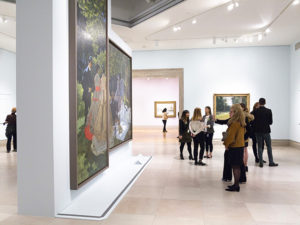 It is an art exhibition with your favorite paintings even though you probably have never seen them; it offers a new way of looking at the work of a familiar, great artist; it is 100% a delight. All that and more is what visitors to MONET: The Early Years will find at the Legion of Honor Museum, San Francisco, from right now to May 29, 2017. As advised by Max Hollein, Director of the Fine Arts Museums San Francisco, do not wait until the last week to go to this show! Monet is such a well-loved artist; the museum is expecting crowds. Do not wait; you will want to linger once you are there and you will also want to return.
It is an art exhibition with your favorite paintings even though you probably have never seen them; it offers a new way of looking at the work of a familiar, great artist; it is 100% a delight. All that and more is what visitors to MONET: The Early Years will find at the Legion of Honor Museum, San Francisco, from right now to May 29, 2017. As advised by Max Hollein, Director of the Fine Arts Museums San Francisco, do not wait until the last week to go to this show! Monet is such a well-loved artist; the museum is expecting crowds. Do not wait; you will want to linger once you are there and you will also want to return.
A Hut at Sainte-Adresse (1867) 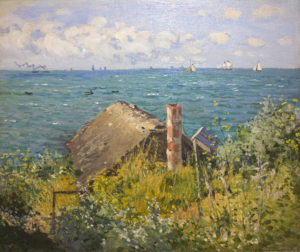 The first of Monet’s views of the sea from the perspective of an overlooking high cliff. It has a foreground that has mixed levels, grasses and undergrowth. The beat up looking hut is at a lower level than the vegetation on the hill, and the sea presents calm water in the sunlight with white sails at the horizon. It was important to Monet; he showed it in 1868 and then three more times through the next two decades.
The first of Monet’s views of the sea from the perspective of an overlooking high cliff. It has a foreground that has mixed levels, grasses and undergrowth. The beat up looking hut is at a lower level than the vegetation on the hill, and the sea presents calm water in the sunlight with white sails at the horizon. It was important to Monet; he showed it in 1868 and then three more times through the next two decades.
Claude Monet (1840-1926) is so well known: the man with the long beard in his garden at Giverny, the paintings of water lilies, haystacks at different times of day, the train station. It is hard to imagine him young, penniless, struggling to earn recognition as well as to pay his rent and buy food. The works in the exhibition come from 1858 , his first exhibited work, to 1872. This is the Monet whose paintings inhabit the exhibition. The paintings enliven each gallery with the young master’s color and light. They also represent surprising genres including still lifes, portraits, and genre paintings in addition to the landscapes with which he will be identified in the future. He did the earliest painting in the show when he was 18; in his 20s he is already brilliant in his presentation of deep forests, blustery seascapes, people who become color in motion on the beach or by a pool.
La Grenouillier (1869) In this summer, Renoir literally sustained Monet and Camille bringing them bread. The two painters spent time together at this atmospheric swimming spot with cafe as well as a walkway and pool. Renoir painted three pictures and Monet made this and aother. Painting the light and colors reflected in the water seems to have fascinated Monet. He shows people moving in different directions, creating new dimensions. The distant trees in pale yellow-green contrast with the wavy, cool, blue black water. 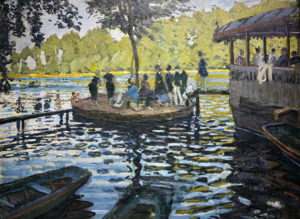
He traveled to the Netherlands and to London in search not only of new subjects but also new buyers. He was able to sell work especially in the Netherlands. The visitor to the exhibition will find examples of his brilliant painting which do not look entirely like the later, more familiar Monet. He traveled with his lover, Camille Doncieux, who became the mother of his child and, later, his wife. There are touching, intimate portraits of both Camille and the infant, Jean. These paintings reveal characteristics of Camille and also the tenderness of the artist.
The Cradle (1867) Camille and Monet’s son, born during a time of poverty and struggle is presented here with a joyful intimacy. The figure is Julie Vellay, Pissarro’s future wife.
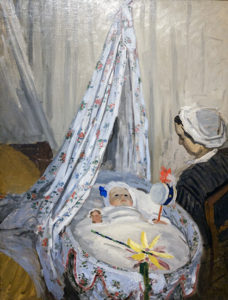
The Red Kerchief (ca. 1869) is a touching glimpse of Camille glancing in the artist’s window. Monet kept this painting with him his whole life. Camille passed away in 1879.
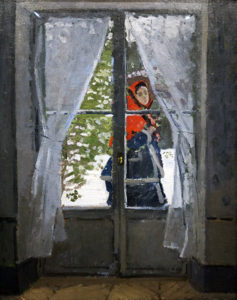
The Magpie (1869) shows a countryside in deep snow. The pale branches of the trees are lined with snow. There is a fence, and a magpie sits on the gate. To look at this painting is to learn that snow is not only white, in fact, depending on the light cast on it, it is violet, pink and gray in and out of shadow. There are no humans in this scene, but the hedge, trees, and bird are full of life in the quiet landscape. Its light is glorious, making a scene that should be cold offer depth, balance, harmony.
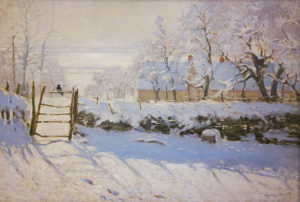
In 1871, Monet and his family fled Paris to escape the Franco-Prussian War. He returned in 1872 to settle in Argenteuil about 12 miles out of Paris. There he painted the towpath along the river at different times of day, an anticipation of magnificent series to come. By this time, he had achieved financial peace of mind and also found recognition amongst his peers. He exhibited with Renoir, Cezanne, Degas, Pissarro, and Sisley, in 1874, in the first Impressionist Exhibition and in the second Impressionist Exhibition, 1876. His mastery of his own style was apparent. This is a great exhibition.
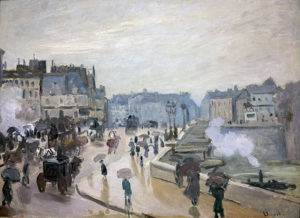 The Pont Neuf in Paris, an Impression (1872) “An impression” meant both a quick look and the result of the artist’s quick look. The small figures with umbrellas wending their way across a bridge recall the Japanese art which excited Parisian artists beginning in the 1850s. The Pont Neuf’s urban setting offers different visions according to the changing light. The slick street, the puff of smoke from a boat, the darker traffic to the side; the color reflects the movement of objects and people creating their own patterns in a cloudy world.
The Pont Neuf in Paris, an Impression (1872) “An impression” meant both a quick look and the result of the artist’s quick look. The small figures with umbrellas wending their way across a bridge recall the Japanese art which excited Parisian artists beginning in the 1850s. The Pont Neuf’s urban setting offers different visions according to the changing light. The slick street, the puff of smoke from a boat, the darker traffic to the side; the color reflects the movement of objects and people creating their own patterns in a cloudy world.
Monet: The Early Years was organized by the Kimbell Art Museum in collaboration with the Fine Arts Museums of San Francisco. George T.M. Shackelford, the Kimbell’s Deputy Director, is the curator of the exhibition. Esther Bell is the FAMSF Curator in Charge, European Paintings. For more information, see legionofhonor.org/monet Museum hours: Tues-Sun 9:30 a.m.-5:15 p.m.
photos: All photos by Jonathan Clark, Mountain View, CA.
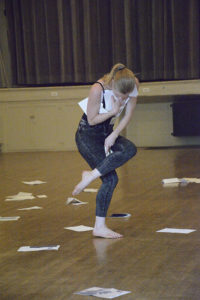 ELISABETH KINDLER-ABALI, visiting artist from Berlin, premieres “Letters Like Feathers,” by Leslie Friedman, IDF@SV Festival Concert, 2016
ELISABETH KINDLER-ABALI, visiting artist from Berlin, premieres “Letters Like Feathers,” by Leslie Friedman, IDF@SV Festival Concert, 2016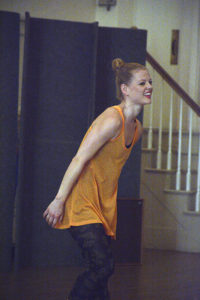 Elisabeth Kindler-Abali bows after performing US premier of her work BUTTERFLY at IDF@SV Festival Concert, 2016.
Elisabeth Kindler-Abali bows after performing US premier of her work BUTTERFLY at IDF@SV Festival Concert, 2016.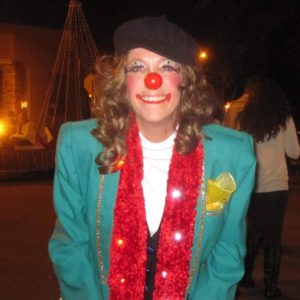 Megan Ivey
Megan Ivey 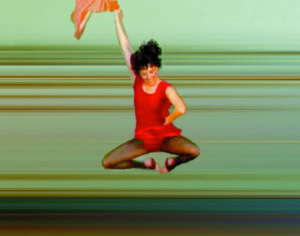

 The first of Monet’s views of the sea from the perspective of an overlooking high cliff. It has a foreground that has mixed levels, grasses and undergrowth. The beat up looking hut is at a lower level than the vegetation on the hill, and the sea presents calm water in the sunlight with white sails at the horizon. It was important to Monet; he showed it in 1868 and then three more times through the next two decades.
The first of Monet’s views of the sea from the perspective of an overlooking high cliff. It has a foreground that has mixed levels, grasses and undergrowth. The beat up looking hut is at a lower level than the vegetation on the hill, and the sea presents calm water in the sunlight with white sails at the horizon. It was important to Monet; he showed it in 1868 and then three more times through the next two decades.



 The Pont Neuf in Paris, an Impression (1872) “An impression” meant both a quick look and the result of the artist’s quick look. The small figures with umbrellas wending their way across a bridge recall the Japanese art which excited Parisian artists beginning in the 1850s. The Pont Neuf’s urban setting offers different visions according to the changing light. The slick street, the puff of smoke from a boat, the darker traffic to the side; the color reflects the movement of objects and people creating their own patterns in a cloudy world.
The Pont Neuf in Paris, an Impression (1872) “An impression” meant both a quick look and the result of the artist’s quick look. The small figures with umbrellas wending their way across a bridge recall the Japanese art which excited Parisian artists beginning in the 1850s. The Pont Neuf’s urban setting offers different visions according to the changing light. The slick street, the puff of smoke from a boat, the darker traffic to the side; the color reflects the movement of objects and people creating their own patterns in a cloudy world.